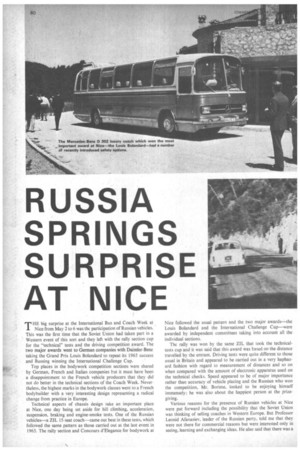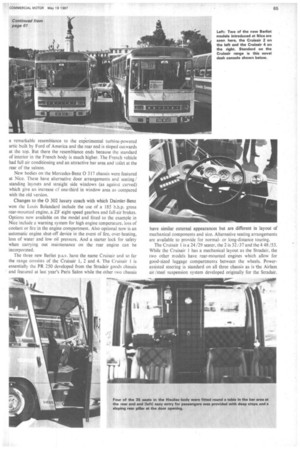RUSSIA SPRINGS SURPRISE AT NICE
Page 62

Page 63

Page 67

If you've noticed an error in this article please click here to report it so we can fix it.
THE big surprise at the International Bus and Coach Week at Nice from May 2 to 6 was the participation of Russian vehicles. This was the first time that the Soviet Union had taken part in a Western event of this sort and they left with the rally section cup for the "technical" tests and the driving competition award. The two major awards went to German companies with Daimler-Benz taking the Grand Prix Louis Bolandard to repeat its 1965 success
and Bussing winning the International Challenge Cup. • Top places in the bodywork competition sections were shared by German, French and Italian companies but it must have been a disappointment to the French vehicle producers that they did not do better in the technical sections of the Coach Week. Nevertheless, the highest marks in the bodywork classes went to a French bodybuilder with a very interesting design representing a radical change from practice in Europe.
Technical aspects of chassis design take an important place at Nice, one day being set aside for hill climbing, acceleration, suspension, braking and engine-smoke tests. One of the Russian vehicles—a ZIL 15-seat coach—came out best in these tests, which followed the same pattern as those carried out at the last event in 1965. The rally section and Concours d'Elegance for bodywork at Nice followed the usual pattern and the two major awards—the Louis Bolandard and the International Challenge Cup—were awarded by independent committees taking into account all the individual sections.
The rally was won by the same ZIL that took the technicaltests cup and it was said that this award was based on the distance travelled by the entrant. Driving tests were quite different to those usual in Britain and appeared to be carried out in a very haphazard fashion with regard to measurement of distances and so on when compared with the amount of electronic apparatus used on the technical checks. Speed appeared to be of major importance rather than accuracy of vehicle placing and the Russian who won the competition, Mr. Borime, looked to be enjoying himself immensely; he was also about the happiest person at the prizegiving.
Various reasons for the presence of Russian vehicles at Nice were put forward including the possibility that the Soviet Union was thinking of selling coaches in Western Europe. But Professor Leonid Afanasiev, leader of the Russian party, told me that they were not there for commercial reasons but were interested only in seeing, learning and exchanging ideas. He also said that there was a desire to demonstrate the friendship between the Soviet Union and France. Most of the Russian party were engineers or body designers, including Mr. Dolmatovsky, head of the department of transport at the Russian Institute of Industrial Design.
Tilt aspect of learning is an important one at Nice where engineers from vehicle makers are always present in good numbers, comparing the performance of their vehicles with that of competitors. There is also a considerable prestige value in doing well and with technical novelty important in this connection new designs are frequently introduced here. This time a number of changes to Mercedes-Benz chassis were announced—these helped to win the top prize—and Berliet had three new passenger designs.
There were five Russian chassis, three LAZ (made in Lvov), the Z1L which won the two awards and a prototype PAZ luxury coach. The PAZ is made in a town called Pavolovo which is near Gorkt, where GAZ chassis are produced.
GAZ components including a 4.5 litre V8 petrol engine are used and it was interesting that the body design bore a similarity to that of the Heuliez-bodied SAVIEM which got the highest marks in the bodywork section. Frontal appearance of both bears a remarkable resemblance to the experimental turbine-powered artic built by Ford of America and the rear end is sloped outwards at the top. But there the resemblance ends because the standard of interior in the French body is much higher. The French vehicle had full air conditioning and an attractive bar area and toilet at the rear of the saloon.
New bodies on the Mercedes-Benz 0 317 chassis were featured at Nice. These have alternative door arrangements and seating/ standing layouts and straight side windows (as against curved) which give an increase cf one-third in window area as compared with the old version.
Changes to the 0 302 luxury coach with which Daimler-Benz won the Louis Bolandard include the use of a 185 b.h.p. gross rear-mounted engine, a ZF eight-speed gearbox and full-air brakes. Options now available on the model and fitted to the example in Nice include a warning system for high engine temperature, loss of coolant or fire in the engine compartment. Also optional now is an automatic engine shut-off device in the event of fire, over-heating, loss of water and low oil pressure. And a starter lock for safety when carrying out maintenance on the rear engine can be incorporated.
The three new Berliet p.s.v. have the name Cruisair and so far the. range consists of the Cruisair 1, 2 and 4. The Cruisair 1 is essentially the PR 250 developed from the Stradair goods chassis and featured at last year's Paris Salon while the other two chassis have similar external appearances but are different in layout of mechanical components and size. Alternative seating arrangements are available to provide for normalor long-distance touring.
The Cruisair 1 is a 24/29 seater, the 2 is 32/37 and the 4 48/53. While the Cruisair 1 has a mechanical layout as the Stradair, the two other models have rear-mounted engines which allow for good-sized luggage compartments between the wheels. Powerassisted steering is standard on all three chassis as is the Airlam air /steel suspension system developed originally for the Stradair.




















































































































